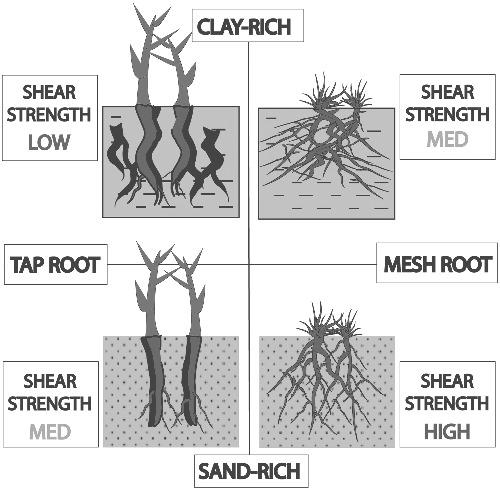当前位置:
X-MOL 学术
›
Earth Surf.Process. Land.
›
论文详情
Our official English website, www.x-mol.net, welcomes your
feedback! (Note: you will need to create a separate account there.)
Effect of vegetation cover and sediment type on 3D subsurface structure and shear strength in saltmarshes
Earth Surface Processes and Landforms ( IF 2.8 ) Pub Date : 2021-06-05 , DOI: 10.1002/esp.5174 Clementine Chirol 1 , Kate L. Spencer 1 , Simon J. Carr 2 , Iris Möller 3 , Ben Evans 4 , Jason Lynch 5 , Helen Brooks 4 , Katherine R. Royse 6
Earth Surface Processes and Landforms ( IF 2.8 ) Pub Date : 2021-06-05 , DOI: 10.1002/esp.5174 Clementine Chirol 1 , Kate L. Spencer 1 , Simon J. Carr 2 , Iris Möller 3 , Ben Evans 4 , Jason Lynch 5 , Helen Brooks 4 , Katherine R. Royse 6
Affiliation

|
The vulnerability of saltmarshes to lateral erosion at their margin depends on the local biogeomorphological properties of the substrate. In particular, the 3D architecture of pore and root systems is expected to influence shear strength, with repercussions for the wider-scale stability of saltmarshes. We apply X-ray computed microtomography (μCT) to visualize and quantify subsurface structures in two UK saltmarshes at Tillingham Farm, Essex (silt/clay rich substrate) and Warton Sands (sand-rich substrate), with four types of ground cover: bare ground, Spartina spp, Salicornia spp and Puccinellia spp. We extracted μCT structural parameters that characterize pore and root morphologies at each station, and compared them with field measurements of shear strength using a principal component analysis and correlation tests. The 3D volumes show that species-dependent variations in root structures, plant colonization events and bioturbation activity control the morphology of macropores, while sediment cohesivity determines the structural stability and persistence of these pore structures over time, even after the vegetation has died. Areas of high porosity and high mean pore thickness were correlated to lower values of shear strength, especially at Tillingham Farm, where well-connected vertical systems of macropores were associated with current or previous colonization by Spartina spp. However, while well-connected systems of macropores may lower the local deformation threshold of the sediment, they also encourage drainage, promote vegetation growth and reduce the marsh vulnerability to hydrodynamic forces. The highest values of shear strength at both sites were found under Puccinellia spp, and were associated with a high density of mesh-like root structures that bind the sediment and resist deformation. Future studies of marsh stability should ideally consider time series of vegetation cover, especially in silt/clay-dominated saltmarshes, in order to consider the potential effect of preserved buried networks of macropores on water circulation, marsh functioning and cliff-face erosion.
中文翻译:

植被覆盖和沉积物类型对盐沼中 3D 地下结构和剪切强度的影响
盐沼对边缘侧蚀的脆弱性取决于基质的局部生物地貌特性。特别是,孔隙和根系的 3D 结构预计会影响剪切强度,并对盐沼更广泛的稳定性产生影响。我们应用 X 射线计算机显微断层扫描 (μCT) 来可视化和量化位于埃塞克斯郡 Tillingham 农场的两个英国盐沼(富含淤泥/粘土的基质)和 Warton Sands(富含沙的基质)的地下结构,有四种类型的地面覆盖物:裸露地面、Spartina spp、Salicornia spp和Puccinellia spp. 我们提取了表征每个站点孔隙和根部形态的 μCT 结构参数,并使用主成分分析和相关性测试将它们与剪切强度的现场测量值进行了比较。3D 体积显示,根结构、植物定植事件和生物扰动活动的物种依赖性变化控制着大孔的形态,而沉积物内聚力决定了这些孔结构随时间的结构稳定性和持久性,即使在植被死亡之后也是如此。高孔隙率和高平均孔隙厚度的区域与较低的剪切强度值相关,尤其是在 Tillingham 农场,在那里连接良好的大孔隙垂直系统与Spartina spp当前或以前的定殖有关. 然而,虽然连接良好的大孔隙系统可能会降低沉积物的局部变形阈值,但它们也能促进排水、促进植被生长并降低沼泽对水动力的脆弱性。在Puccinellia spp下发现了两个地点的最高剪切强度值,并且与高密度的网状根结构结合在一起并抵抗变形。未来对沼泽稳定性的研究应该理想地考虑植被覆盖的时间序列,特别是在以淤泥/粘土为主的盐沼中,以考虑保留的大孔隙埋藏网络对水循环、沼泽功能和悬崖面侵蚀的潜在影响。
更新日期:2021-06-05
中文翻译:

植被覆盖和沉积物类型对盐沼中 3D 地下结构和剪切强度的影响
盐沼对边缘侧蚀的脆弱性取决于基质的局部生物地貌特性。特别是,孔隙和根系的 3D 结构预计会影响剪切强度,并对盐沼更广泛的稳定性产生影响。我们应用 X 射线计算机显微断层扫描 (μCT) 来可视化和量化位于埃塞克斯郡 Tillingham 农场的两个英国盐沼(富含淤泥/粘土的基质)和 Warton Sands(富含沙的基质)的地下结构,有四种类型的地面覆盖物:裸露地面、Spartina spp、Salicornia spp和Puccinellia spp. 我们提取了表征每个站点孔隙和根部形态的 μCT 结构参数,并使用主成分分析和相关性测试将它们与剪切强度的现场测量值进行了比较。3D 体积显示,根结构、植物定植事件和生物扰动活动的物种依赖性变化控制着大孔的形态,而沉积物内聚力决定了这些孔结构随时间的结构稳定性和持久性,即使在植被死亡之后也是如此。高孔隙率和高平均孔隙厚度的区域与较低的剪切强度值相关,尤其是在 Tillingham 农场,在那里连接良好的大孔隙垂直系统与Spartina spp当前或以前的定殖有关. 然而,虽然连接良好的大孔隙系统可能会降低沉积物的局部变形阈值,但它们也能促进排水、促进植被生长并降低沼泽对水动力的脆弱性。在Puccinellia spp下发现了两个地点的最高剪切强度值,并且与高密度的网状根结构结合在一起并抵抗变形。未来对沼泽稳定性的研究应该理想地考虑植被覆盖的时间序列,特别是在以淤泥/粘土为主的盐沼中,以考虑保留的大孔隙埋藏网络对水循环、沼泽功能和悬崖面侵蚀的潜在影响。











































 京公网安备 11010802027423号
京公网安备 11010802027423号